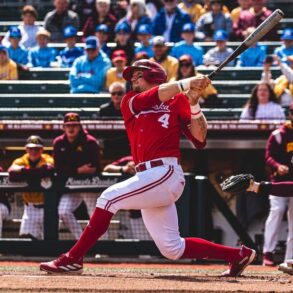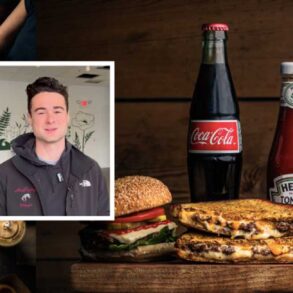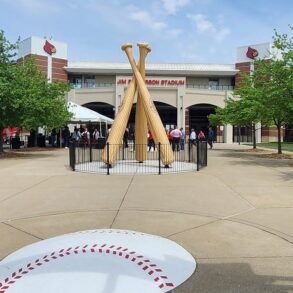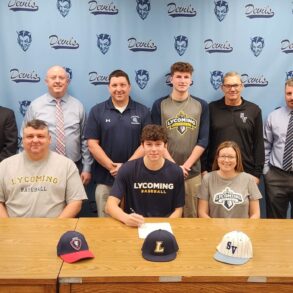Image credit:
Jace LaViolette (Mike Janes/Four Seam Images)
At this time next month, we’ll all be watching college baseball again.
To kick off the final stretch of preseason, here are 30 things to know 30 days before the start of the 2025 season.
1. Who’s the favorite to win it all this year?
Few teams come out of the coaching-change process in as positive a position as Texas A&M did this year after it promoted hitting coach Michael Earley to lead the program in the wake of what could have been an organization-altering shake up—the departure of coach Jim Schlossnagle for rival Texas.
The Aggies’ decision to retain Earley directly influenced the returns of several key players, including outfielder and projected 2025 No. 1 overall pick Jace LaViolette, 2024 SEC freshman of the year Gavin Grahovac, southpaw ace Ryan Prager (who was drafted in the third round last year but didn’t sign), shortstop Kaeden Kent and No. 2 starter Justin Lamkin, among several others. They also signed seven Baseball America top 100 transfers this offseason, infusing even more talent into a roster that was already rich with it.
That’s why it’s hard to pick against the Aggies going into the 2025 season, a sentiment that reigned true among BA staff members and also among coaches who might have to contend with Texas A&M this season. Over the last six weeks, we polled 50 Division I coaches and nearly 85% anonymously picked the Aggies to win the national title, which is an overwhelming consensus.
College baseball is hardly predictable, especially in the transfer era when so many teams are—at least to some degree—relying on multiple players to adequately adjust to new and increasingly difficult levels of competition. It’s clear, though, that the Aggies are the safest pick to win it all a month before any games are even played.
2. If not the Aggies, then who?
Texas A&M might be the favorite to win it all in 2025, but that hardly means there aren’t other teams generating buzz. If the Aggies are the standard, it feels like Arkansas, LSU, Tennessee and Virginia are on their heels, with Clemson, Duke, Georgia, Florida, Florida State, North Carolina and Oregon State in another, not-so-far-behind tier.
Dating back to 2018, the last five national champions have come from the SEC, a trend that will be reflected in Baseball America’s preseason rankings, which could feature over half the league’s teams. However, the ACC, which claimed half of the eight spots in last year’s College World Series, is loaded too, and the Beavers are arguably the most promising independent national-title contender since Miami actually won it as a conference-less program in 1999 and 2001.
3. With that in mind, what’s a reasonable prediction for an Omaha field of eight heading into the year?
Remember, this is a prediction based entirely on which teams I believe have the most reasonable paths to the College World Series. There are always wrinkles and upsets that can’t be predicted earnestly this far in advance.
That being said, I would pick Arkansas, Clemson, Florida, Florida State, LSU, Tennessee, Texas A&M and Virginia to be the final eight teams standing in June.
Duke, Georgia, Oregon State, Oklahoma State and North Carolina are right on the outside looking in.
5. Who are the sleepers?
Don’t let the previous prediction, which names just two non-SEC or ACC teams, fool you; college baseball continues to be very talented outside of those conferences. It’s a byproduct of a shortened draft, atrophied minor league system and unrestricted transferring, which has allowed the best players to align with the top programs.
Oregon’s team is built to continue the meteoric rise it has experienced under head coach Mark Wasikowski while mid-major powers like UC Santa Barbara, Dallas Baptist and UC Irvine are all poised to stick with their winning ways. Indiana is coming off back-to-back NCAA Tournament appearances for the first time since it reached the field three-straight times from 2017-19 and is brimming with offensive firepower, including Player of the Year contender Devin Taylor. The same can be said for a team like Arizona, which is looking to make its return to Omaha for the first time since 2021.
5. Which fanbase will be crowned Rocco’s College World Series Jell-O Shot Challenge victor?
Yes, this is important. Yes, I predicted LSU would return to Omaha in 2025. No, I’m not picking against that fanbase in a contest it dominates.
6. Will the first-time host streak continue?
Though it shared hosting duties with Santa Clara in 1972, we’re going to give UC Santa Barbara first-time regional host status, as it welcomed teams to its park for the first round of the NCAA Tournament by itself for the first time in 2024. The Gauchos grew the streak to six consecutive years of the tournament featuring a first-time host. I’m guessing it continues this year with Duke my leading candidate to make it happen.
7. Which teams that missed the 2024 NCAA Tournament could make it in 2025?
I’ll preface this by saying that there are certainly more than six teams which missed the tournament last year that could make a run. Here are some I really like, listed alphabetically:
Auburn: The Tigers missed the postseason for just the second time in nine seasons with a tournament under head coach Butch Thompson and won just eight SEC games, which tied their fewest since conference schedules moved to 30 contests in the early 1990s. In need of a rapid course correction, Thompson brought in five top 100 transfers and wound up with the No. 4 class, which could be enough to vault them back to competitive status.
Charleston: There was arguably no bigger snub from last year’s field than Charleston, the only team in the nation with 40 or more total wins (41) and a top-50 RPI to get denied. Head coach Chad Holbrook was quite understandably livid—and vocal—about it then put together a roster that should once again be highly competitive.
Northeastern: Baseball America’s final projected field of 64 last year included Northeastern as a No. 3 seed in the Raleigh Regional after the Huskies won 38 games and produced one of their best seasons under head coach Mike Glavine. But, after coming up short in the CAA tournament, they missed out on a third postseason appearance in four years, which would have marked their best stretch of that length in team history. The Huskies have produced winning percentages of at least .630 in five of their last seven seasons. Similar success this year could provide entry to the field.
Stanford: After six-straight postseason appearances, including three-consecutive trips to Omaha from 2021-23, the Cardinal won just 22 games in 2024, as youth got the best of them. That young roster had plenty of talent, though, and most of it is back in the fold for head coach David Esquer, who also added Japanese slugger Rintaro Sasaki to the mix. More on Sasaki later. The maturation process could be a boon to the Cardinal in their ACC debut.
TCU: The Horned Frogs missed the tournament entirely last season after reaching Omaha the year before but put themselves on a nice trajectory to bounce back in 2025. Fourth-year head coach Kirk Saarloos went into the portal and grabbed former Wichita State righty Tommy LaPour, who could start or close this year with electric stuff. TCU also returns lefty Ben Abeldt, who thrived in a reliever role but could make a jump to the weekend rotation.
Troy: The Trojans won 37 total games and 18 in conference action but couldn’t secure one of the four tournament spots that went to Sun Belt teams. Fourth-year coach Skylar Meade brought in a large group of transfers who add experience to Troy’s roster and position it nicely for a second postseason trip in a three-year stretch.
8. Speaking of a potentially resurgent Stanford, what does Rintaro Sasaki mean for the Cardinal?
When you’re getting mentioned in the same sentence as Shohei Ohtani, it can be easy for expectations to soar and that’s happened to some degree with the Cardinal freshman, who was in contention to be selected first overall in the NPB draft before deciding to move stateside. Sasaki put up gaudy numbers at Hanamaki-Higashi High School—the same school that produced Ohtani—where he was coached by his father. The 6-foot, 250-pound first baseman slashed .413/.514/.808 and punished a Japanese high school record 140 home runs, showing off his elite power and plus feel-to-hit.
While it would be unfair to put superstar expectations on Sasaki right out the gate, it’s probably safe to say that Stanford has a bonafide contender for Freshman of the Year as well as a youngster who could blossom into something special. By foregoing pro baseball in Japan, Sasaki is not subject to international amateur rules and will be draft-eligible in 2027.
9. Who are other sluggers to watch?
If it’s home runs you seek, college baseball should once again provide. Dating back to 2002, only 75 Division I players have hit 25 or more home runs in a single season and a third of them have come in the last two years.
Of the 15 players who accomplished the feat last season, four return to the college ranks in 2025: LSU first baseman Jared Jones (28), Texas A&M outfielder Jace LaViolette (28), UNC Wilmington first baseman Tanner Thach (27), and Georgia Tech outfielder Drew Burress (25).
That quartet should pop again this year and it’s safe to add players like Miami infielder Daniel Cuvet, Oklahoma State outfielder Nolan Schubart, Virginia outfielder Harrison Didawick and Texas A&M third baseman Gavin Grahovac to the list of guys to keep an eye on in the power department.
10. Who are the frontrunners for Player of the Year?
The last few seasons have offered some elite individual performances and Player of the Year races. Here are 10 players who could make for similar excitement in 2025:
Jamie Arnold (Florida State): A first-team all-American as a sophomore last season, Arnold dominated with a 2.98 ERA and 159 strikeouts over 105.2 innings, including the first 17-strikeout performance by a Seminole pitcher since 1987. Arnold should vie to be the first pitcher—if not player—off the board in this year’s draft.
Aiva Arquette (Oregon State): The 6-foot-4 Arquette hit .311 with 17 home runs, 14 doubles, 47 RBI and nine stolen bases in 63 games across two seasons at Washington before hitting the portal and finding a new home at Oregon State, where he’ll anchor the heart of the batting order and attempt to give the Beavers first-round picks in back-to-back years for the first time since 2018-19.
Tyler Bremner (UC Santa Barbara): Bremner showed the country he meant business as a sophomore last year when he posted a 2.54 ERA and 104 strikeouts to just 21 walks in 88.2 innings and returned to the Gauchos as one of the premier arms in college ball. Barring something unforeseen, Bremner should push Arnold for first pitcher off the board.
Cam Cannarella (Clemson): From defensive highlights that are reminiscent of some of baseball’s all-time greats and a well-rounded offensive approach that produced a .337/.417/.561 line with 16 doubles, 11 home runs and 60 RBI in 58 games last year, Cannarella ranks among the elites heading into 2025 and has early-first round buzz for this year’s draft, too.
Gabe Gaeckle (Arkansas): The righthanded Gaeckle pitched exclusively from Arkansas’ bullpen on a loaded staff as a freshman in 2024 but dominated in the role with a 2.32 ERA, seven saves, 57 strikeouts and 19 walks in 42.2 innings. He’ll serve as the frontman for another star-stuffed Razorbacks pitching staff as a sophomore this year.
Henry Ford (Virginia): The 6-foot-5, 220-pound Ford established himself as one of the nation’s top underclassmen last year when he hit .336 with 17 home runs, 13 doubles, 69 RBI and a thunderous .261 ISO. The draft-eligible sophomore is making the move to right field this season, per head coach Brian O’Connor, who told Baseball America that he believed the corner outfield was Ford’s “future in this game.”
Jace LaViollete (Texas A&M): The 6-foot-6, 230-pound slugger produced an impressive 108.8 90th percentile exit velocity and limited his chase rate to just 17.2 percent as a sophomore in 2024 when he slashed .305/.449/.726 with 29 home runs, 78 RBI and 64 walks against 81 strikeouts. LaViolette generates impressive impact and has double-plus raw power to all fields, which he gets to with ease in games.
Nolan Schubart (Oklahoma State): Schubart took advantage of the hitter-friendly home confines of O’Brate Stadium as a sophomore last season and finished the year ranked first in the Big 12 in home runs, on-base percentage, OPS and RBI. With 2024 first-round pick Carson Benge no longer in the fold, it’s Schubart’s turn to take the reins of a potent Cowboys offense.
Luke Stevenson (North Carolina): North Carolina seems to have the complete package behind the plate with Stevenson, who last year as a freshman catcher hit .284/.420/.535 with eight doubles, 14 home runs and 58 RBI. The draft-eligible sophomore is one of the best receivers in college baseball this year, too, and could gain helium up draft boards and Player of the Year rankings with another well-rounded season on a team capable of an Omaha run.
Devin Taylor (Indiana): Taylor made history last season when he became the first Hoosier ever to earn first-team all-Big Ten honors in his first two college seasons and also finished the campaign ranked second all-time in total home runs hit by an Indiana player in his first two seasons. He’s on track to be an early first-rounder in 2025.
11. Some of college baseball’s top players this season will play for new schools. Who are some notable ones?
We’ve already looked at Arquette and mentioned TCU’s Tommy LaPour. Here are three more transfers that caught Baseball America’s eye:
Gavin Kilen (Tennessee): Looking to replace the production of several key offensive departures, the Volunteers reeled in Kilen, the former Louisville shortstop, giving them one of the premier middle infields in college baseball, as they also return shortstop Dean Curley. Killen put together a career year in 2024 with a .330/.361/.591 line, 23 doubles, nine home runs and 41 RBI.
Kyle Walker (Arizona State): A contact expert who makes the most of every swing, Walker .hit 384/.508/.611 with 11 doubles, 11 home runs and a career-high 43 RBI in his final season at Grambling State. The second baseman joins the Sun Devils with a chance to make a big impression against heightened competition.
Niko Urquidi (Cal Baptist): I decided to go to the mid-major level with my third and final transfer and felt there was no pick more intriguing than Urquidi, a southpaw for Cal Baptist. As a freshman at Division-III La Verne last year, he dominated with a 2.80 ERA, 102 strikeouts and a shutout in 83.2 innings. It should be interesting to see what he can do against Division-I batters.
12. Which schools put together the best portal hauls?
Five teams brought in at least five top-100 transfers this offseason to build out what Baseball America evaluated to be the top classes: LSU (nine), Arkansas (8), Texas A&M (7), Auburn (5), and Georgia (5).
13. Some coaches hit the portal too. Which coaching moves stood out most?
The biggest coaching change of the offseason absolutely belongs to Jim Schlossnagle, who left Texas A&M after a run to the College World Series finale for the head job at rival Texas. Indiana State head coach Mitch Hannahs took over at South Florida and was replaced by former Southern Indiana coach Tracy Archuleta. Minnesota’s John Anderson, Missouri State’s Keith Gutin and Coastal Carolina’s Gary Gilmore, all of whom spent multiple decades atop their respective programs, entered retirement and were replaced by Ty McDevitt, Joey Hawkins and Kevin Schnall, respectively. Ohio State’s Bill Mosiello resigned and was succeeded by Justin Haire.
One other particularly notable change: former LSU coach Paul Mainieri took over the helm at South Carolina after Mark Kingston’s firing. Kingston then moved on to Creighton, where he is coach-in-waiting under Ed Servais, who is set to retire after this season.
14. How will Mainieri fare in his return to college baseball?
If you ask many of his colleagues across the sport, the short answer is “well.” The 2009 national champion, 2009 Baseball America Coach of the Year, four-time SEC and Big East champion and one of the winningest coaches in college baseball history, Mainieri told Baseball America that he truly felt like he was ready to walk away from coaching when he announced his retirement in 2021.
But the saying “absence makes the heart grow fonder” really held true in this case, and it led the 67-year-old back to the sport with renewed energy.
15. There were some teams that entered the transfer portal this offseason. Who did it at the Power 4 level?
We’ll break it down by conference to make it easy.
ACC newcomers: Cal, SMU, Stanford
Big-12 newcomers: Arizona, Arizona State, Utah
Big Ten newcomers: Oregon, Washington, UCLA, USC
SEC newcomers: Oklahoma and Texas
17. Not listed above? Oregon State. So what’s ahead for them?
Oregon State head coach Mitch Canham said when it came time to decide how the Beavers would handle baseball after the Pac-12 disbanded, the move to independence wasn’t really a difficult one. Oregon State essentially opted to prioritize the ability to set its own schedule, which would build in tough opponents and best build its postseason resume.
The Beavers will spend the first three weeks of their season on the road participating in three-straight early-season tournaments before embarking on what would typically be a conference schedule. During that stretch, Oregon State will face four teams—San Diego, Nebraska, UC Irvine and Oregon—that finished the 2024 season ranked among the top-50 in RPI. A strong win total should still be enough to propel Oregon State into the postseason.
It’s unclear what lies beyond 2025 when it comes to Oregon State’s conference alignment.
17. What are five Opening Day matchups to get excited about?
Clemson vs. Oklahoma State (Arlington, Texas): The Tigers and Cowboys are set to open their seasons with a top 15 matchup at noon ET in Texas at Globe Life Field. These are two teams that could easily face each other late in the postseason.
Texas vs. Louisville (Arlington, Texas): Clemson and Oklahoma State’s noon showdown in Arlington should be the perfect table-setter for a 7 p.m. meeting between Jim Schlossnagle’s Texas and a Louisville squad that found itself on the wrong side of the tournament bubble last year.
Duke vs. Cincinnati (Durham, NC): It’s not quite Clemson-Oklahoma State or Texas-Louisville, but Duke’s opening weekend series at home against Cincinnati is nothing to scoff at either. The Blue Devils are still searching for their first trip to Omaha since 1961, and Cincinnati barely missed out on last year’s tournament after a solid season in the Big 12. This should be a good early test for both squads.
Florida State vs. James Madison (Tallahassee, Fla.): This is an intriguing matchup for a few reasons. First, this is a pretty solid non-invitational opening weekend matchup. Florida State is looking to return to the College World Series and James Madison was Baseball America’s fifth team out in its final projected Field of 64 last year. Second, it will almost certainly provide us with our first 2025 look at Jamie Arnold as he begins his quest to claim the title of top pitching in college baseball this season.
North Carolina vs. Texas Tech (Chapel Hill, NC.): The Tar Heels reached Omaha in 2024 and are looking to make it two years in a row, a task that begins with a very solid Texas Tech squad at home at 4 p.m. ET.
18. What’s this double first-base bag all about?
College baseball is introducing a few rule changes this year, some of which will be more visible than others, like the freshly implemented double-bag rule, which will be in effect for conference games in leagues that choose to use it as well as during all Division-I NCAA Tournament games.
The setup is rather simple: An orange or green bag will be situated in foul territory adjacent to the traditional first-base bag, which is in fair territory. On most standard plays, the runner will step on the colored bag while the field will use the traditional base. The batter and runner are required to switch in the event of dropped third strikes and the runner can choose a bag in the event of an errant throw. The NCAA believes the change will decrease the number of collisions at first and limit runner’s lane interference calls.
19. What about sticky-substance checks?
MLB cracked down on overly-tacky substances on pitchers’ hands in 2021 by implementing in-game checks to catch it. College baseball was slow to follow suit, deciding that, up until this year, less frequent checks at the requests of coaches would be more appropriate. However, coaches thought this method was far too relaxed, and this year we’ll see an approach much more similar to the majors as a result. Things could get messy, though, at least to start, as umpires are now tasked with making a decision on what is a fair amount of stick versus a game-alerting amount of tack. Suspensions are in order for pitchers caught in violation of the rule.
20. What’s one prediction for 2025?
This isn’t necessarily bold considering the influx of power hitting in college baseball, but I believe we’ll see the BBCOR-era home run record broken for the fourth-straight year. Ivan Melendez did it in 2022 when he hit 32 blasts, but his mark only lasted a season, as Jac Caglianone hit 33 a year later. In 2024, Charlie Condon upped the mark to 37, though it should be noted that three other players (Caglianone, Christian Moore and Roman Kuntz) tied or beat Caglianone’s mark from the previous season. The ball is flying far in college right now.
Ok, time for the speed rounds. Who are some of the top flamethrowers in the game this year?
21. Nate Snead (Tennessee): Snead’s two-seam fastball might have averaged 96.2 mph, but the pitch can explode into the triple digits and did on occasion last year, hitting 101.3 mph at its peak.
22. Christian Foutch (Arkansas): Working in a set up role for the Razorbacks as a sophomore last year, the righthanded Fouch maintained a 0.81 ERA in 22.1 innings, dusting his competition with a four-seamer that he ran up to 101 mph. Foutch touched 102.3 in the fall, according to head coach Dave Van Horn.
23. Gabe Davis (Oklahoma State): Davis continued to hone his craft largely out of the Cowboys’ bullpen in 2024. Armed with a fastball that can touch triple digits, Davis is likely to jump into a starting role this year as a draft-eligible player.
Which pitchers are ripping fastballs with the most induced vertical break?
24. Justin Guiliano (Purdue): The Boilermakers scored big in the transfer portal when they snagged Canisius southpaw Guiliano, who throws a massive fastball that can get well over 20 inches of vertical break. The 6-foot-4 lefty in 2023 broke the Canisius single-season record for strikeouts per nine innings (13.7).
25. Clayton Weisheit (Indiana): Another player who changed teams this offseason, Weisheit was named to the OVC all-freshman team last year before hitting the portal and joining the Hoosiers.
26. Jacob Mayers (LSU): One of the most intriguing arms in college baseball this year, Mayers has posted nearly as many walks (134) as he has collegiate innings (146.1). The LSU newcomer has also punched out 211 thanks to an outlier fastball with electric life and plenty of velocity.
Who are some returners who punished the ball in 2024?
27. Jacob Krieg (Oregon State): Oregon State is expecting big things from Krieg this year after the infielder claimed the hardest hit ball in Beaver history (118.1 mph).
28. Aaron Graeber (Delaware): A slugger who performed quite well in his first Division-I season, 6-foot-3 Graeber smacked 14 home runs for the Fightin’ Blue Hens and hit a jaw-dropping peak exit velocity of 120.1 mph.
29. Nolan Schubart (Oklahoma State): Few Division-I players who were tasked with managing the same workload as Schubart achieved the exit velocity numbers he did, including a 111.6 mph 90th percentile average.
30. Taylor Gaspar (Stonehill): Gaspar reaped the benefits of searing exit velocities in 2024, growing his career-best home run total from four to 11 while batting .303, which was also a career-best. Gaspar returned to Stonehill for his senior year for a chance at establishing new career marks after peaking at 110.4 mph off the bat last season.
This post was originally published on this site be sure to check out more of their content.







